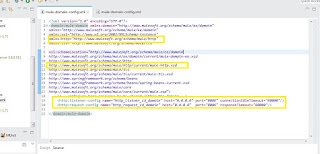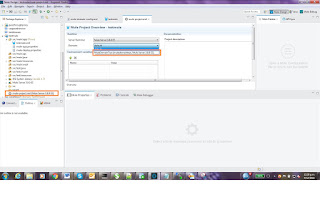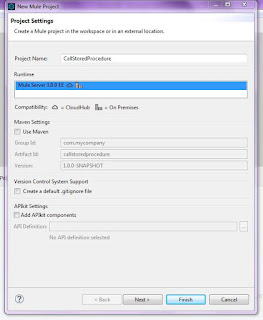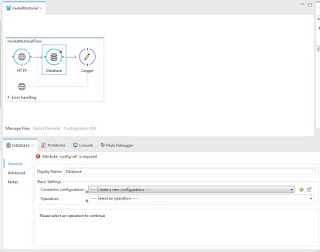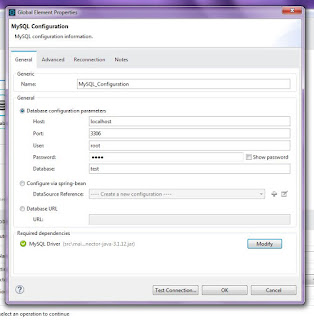Mule Soft ESB provides the facility to share the resources
with other projects, all you need to create a domain project and share the
connector, resources, properties etc. with others projects. If you create a
project individually then every project gets its own domain which is “default
domain”. It means no project shares their resources with other project.
For example if you have created a project and want that
project to be run on a particular port then you can’t run any other project but
if you create a domain project and share its port and base URL then only by the
last part of the URL you can change your flow.
To create a domain project, go to File—New—and select “Mule
Domain Project”.
I have given my project name as “MuleDomainTest”.
Once you create a domain project, you can see 2 files there
in project explorer.
- mule-deploy.properties
- mule-domain-config.xml
You need to add below line in the given XML in “xmlns:domain”
xmlns:http=http://www.mulesoft.org/schema/mule/http
,
http://www.mulesoft.org/schema/mule/http/current/mule-http.xsd
in “xsi:schemaLocation”.
Now you can add below HTTP connector with your port number
and name etc.
<http:listener-config name="http_listner_cd_domain"
host="0.0.0.0" port="8086"
connectionIdleTimeout="60000"/>
<http:request-config name="http_request_cd_domain" host="0.0.0.0" port="8086"
responseTimeout="60000"/>
Make sure that you don’t have any error in compilation.
Code:
<?xml version="1.0" encoding="UTF-8"?> <domain:mule-domain xmlns:domain="http://www.mulesoft.org/schema/mule/ee/domain" xmlns="http://www.mulesoft.org/schema/mule/ee/domain" xmlns:xsi="http://www.w3.org/2001/XMLSchema-instance" xmlns:http="http://www.mulesoft.org/schema/mule/http" xmlns:tls="http://www.mulesoft.org/schema/mule/tls" xsi:schemaLocation="http://www.mulesoft.org/schema/mule/ee/domain http://www.mulesoft.org/schema/mule/ee/domain/current/mule-domain-ee.xsd http://www.mulesoft.org/schema/mule/http http://www.mulesoft.org/schema/mule/http/current/mule-http.xsd http://www.mulesoft.org/schema/mule/tls http://www.mulesoft.org/schema/mule/tls/current/mule-tls.xsd http://www.springframework.org/schema/beans http://www.springframework.org/schema/beans/spring-beans-current.xsd http://www.mulesoft.org/schema/mule/core http://www.mulesoft.org/schema/mule/core/current/mule.xsd"> <!-- configure here resource to be shared within the domain --> <http:listener-config name="http_listner_cd_domain" host="0.0.0.0" port="8086" connectionIdleTimeout="60000"/> <http:request-config name="http_request_cd_domain" host="0.0.0.0" port="8086" responseTimeout="60000"/> </domain:mule-domain>
Now to test this domain project I am creating a small
project which gives a string output. So my first project is “TestMule”. Open
the “mule-project.xml” of this project and select the “MuleTestDomain” (Which we
have created to test) from the domain drop down button.
You can see the connector is coming in “connector
configuration” for “TestMule” project. Once you select this connector means you
have started sharing connector of MuleDomainTest.
Give the path as “/testmule”. I
have added payload as “Hello Mule” here.
In the same way create another project and with the name of “TestHelloWorld” and follow the above
process and select your MuleTestDomain connector.
Here just change the path with “/testhelloworld”.
I have added payload as “Hello World” here.
To run the both project simultaneously, right click on
project go to “Run as” and then
click on “Run Configurations”.
You can see here 2 projects are coming under our new domain.
Select both project “testhelloworld” and “testmule” and click on Run button.
You can see the both project have been deployed under “MuleDomainTest”
Now to test their sharing, hit the both below URL and check
their output by just changing the URL path.
- http://localhost:8086/testhelloworld
- http://localhost:8086/testmule
In the above screen you can see that both project are running
in same domain and both has common base path.



